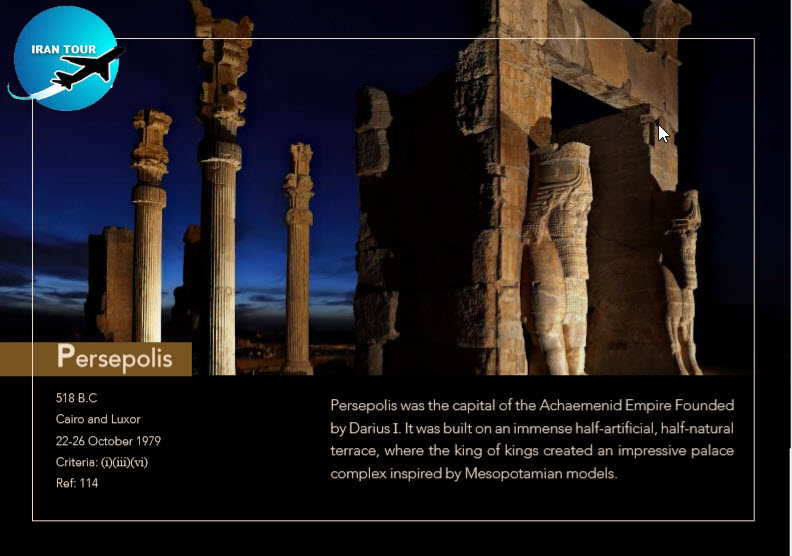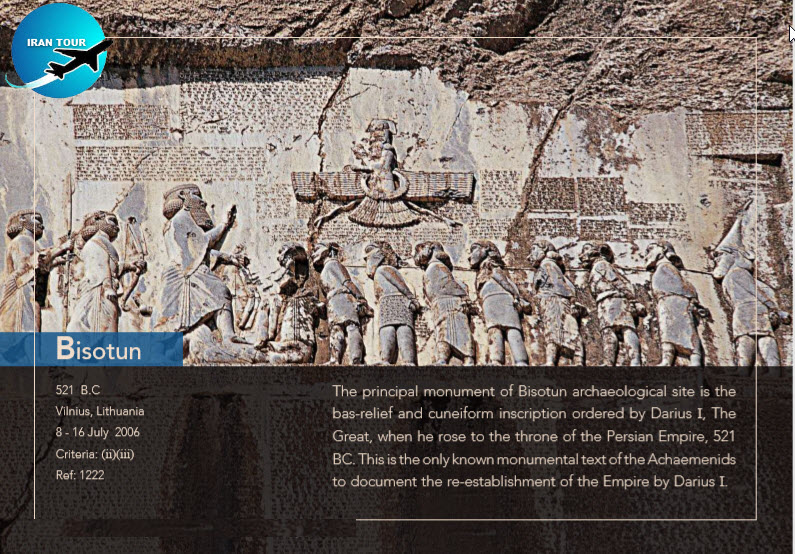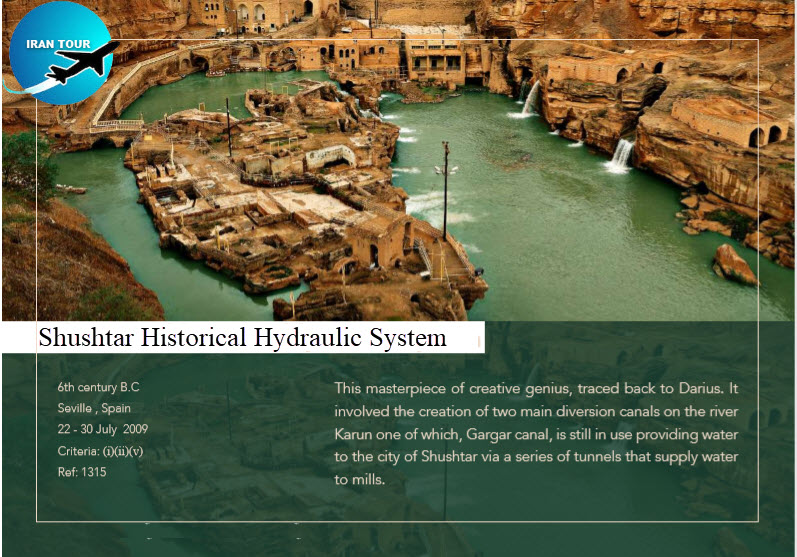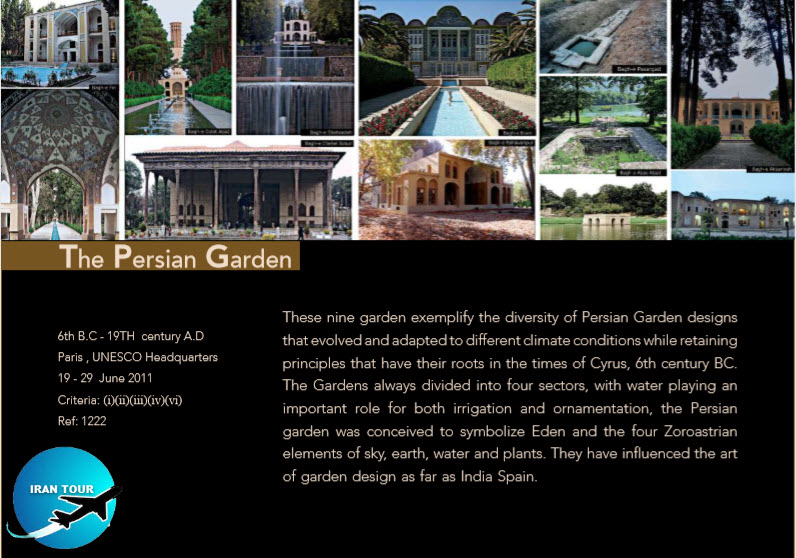Copyright 2020 - 2021 irantour.tours all right reserved
Designed by Behsazanhost
Iran World Heritage Sites
Iran UNESCO Heritage Sites: A Valuable Legacy For All
Iran, with 25 historical monuments and 2 natural features registered by UNESCO and dozens under consideration for registration, is among the top 10 world's historical countries. Iran’s UNESCO World Heritage Sites showcase Iran’s rich cultural and historical legacy. These sites, such as Persepolis, Pasargadae, Naqsh-e Jahan Square, Golestan Palace, Bam and its Cultural Landscape, Takht-e Soleyman, Soltaniyeh, Shushtar Historical Hydraulic System, Tabriz Historic Bazaar Complex, and Susa, reflect the deep-rooted civilization. These magnificent World Heritage Lists represent the country's unique historical, natural beauty, and religious significance. Iran’s inclusion in the UNESCO list is a testament to the importance of preserving and promoting these cultural treasures for future generations. Iran's 27 UNESCO World Heritage Sites showcase its outstanding universal value. Whether tangible or intangible, these sites offer a glimpse into Iran’s rich heritage and serve as a reminder of people's contributions throughout history.
Here is the list of Iran UNESCO Heritage Sites:
 |
||
1-Tchogha Zanbil. Khuzestan Province |
||
 |
||
2-Persepolis Palaces: The glory of Achaemenid architecturePersepolis, 80 km from Shiraz, is the most famous Shiraz historical site and the Achamenian heritage. It is designated as a UNESCO World Heritage Site and shows the grandeur of the Achaemenian Dynasty. The tourists have mentioned it as the best historical site in Shiraz City, Fars Province. This eye-catching architectural Royal palace consists of 8 palaces and various other buildings. It started in 512 BC and was completed 150 years ago. The Achaemenid architecture at Persepolis reflects a unique blend of styles inspired by Babylonia, Assyria, Egypt, the Greek cities of Asia Minor, and the Urartu people. The name “Persepolis” derives from the Greek words Pérses and pólis, translating to “The Persian city” or “the city of the Persians”.
|
||
 |
||
3- Naqsh-e Jahan Square. The most Famous Isfahan Monument
Naqsh-e Jahan Square, the most famous UNESCO World Heritage Site in Isfahan and the focal point of the most important Isfahan historical monuments during the Safavid period was the largest sq at 1502–1736. This magnificent complex was constructed in 1598 - 1629. It is 160 meters (520 ft) wide by 560 meters (1,840 ft) long has an area of 89,600 square meters and is decorated with the best Safavid Era monuments. This expansive square is adorned with stunning examples of Persian architecture, including the magnificent Shah Mosque, the intricate Sheikh Lutfullah Mosque, the grand Ali Qapu Palace, and the ornate Qeysarieh Gate. |
||
 |
||
4- Takht-e Soleyman.
|
||
 |
||
6- Pasargadae Tomb: The Cyrus tomb the founder of Achaemenid Empire
Pasargadae is Cyrus King's Tomb the founder of the Achaemenid Empire. This historical site contains significant remnants of the Achaemenid period, including the Cyrus Tomb, gardens, and royal palaces. Designated as a UNESCO World Heritage Site, Pasargadae showcases the splendid Persian architecture and ancient ruins of the Persian Empire. The Tomb of Cyrus stands as a testament to his legacy and importance in Persian history. Visiting the Pasargadae "Cyrus tomb"+ Persepolis lets you explore the rich history and Achaemenian dynasty's cultural heritage and learn more about the Persian Empire and its historical significance. |
||
 |
||
5- Arg e Bam, Kerman: The World's Largest Adobe Building
A desert castle located on the corner of the Iran desert and the Silk Road shows a great background and deep history from the Achaemenid Empire (2500 years ago) up to recent centuries. Arg e Bam, the world's largest adobe building (20 hectares or 200,000 square meters), is the most important and valuable historical landmark castles in Iran. |
||
 |
||
7- Soltaniyeh ِِDome: A unique Iranian-Mongolian Architectural
The Soltaniyeh Dome in Zanjan province is a UNESCO World Heritage Site and the mausoleum of an Ilkhanid ruler (Oljeitu 1302–12). It is known for its stunning Persian and Islamic architecture. The Soltaniyeh Dome is a main tourism destination, a must-visit landmark close to Zanjan, and a symbol of Persian heritage. It is located in the historical site of Soltanieh city, the previous Ilkhanid Mongol rulers' capital in the 14th century. The dome, was built during Oljaitu, and completed in 712 AH. It remains the second largest domes in the world, after the Santa Maria del Fiore Church in Italy. This historical site is a testament to the rich cultural heritage of Iran and a showcase of its architectural prowess. |
||
 |
||
8- Bisotun Inscription: The most famous Achaemenid stone inscription
The Bisotun or Behistun Inscription is the most famous Achaemenid trilingual inscription and large rock relief located on a cliff face on Behistun Mount in the Kermanshah province. Bisotun Inscription is considered the world’s largest stone inscription and the first well-known Iranian text, dating back to the Achaemenid dynasty around 520 BC. Commissioned by Darius the Great Achaemenian King between 522 BC and 486 BC, the inscription features a detailed autobiography of Darius, including his ancestry and lineage. |
||
 |
||
9- Iranian Armenian Churches: The Most Famous Iran Christian Churches
The Armenian Monastic Ensembles in the West of Iran, embody the rich history of the Armenian community in Iran. These historical churches, including St. Thaddeus Monastery, Saint Stepan Monastery, and the Chapel of Dzordzor, date back to the 7th to 14th centuries A.D. Recognized by UNESCO for their architectural and cultural significance, serve as the most important sacred sites and Christian pilgrimage destinations. |
||
 |
||
10- Shushtar Historical Hydraulic System: An Excellent Ancient Irrigation System
The Shushtar Historical Hydraulic System, located in Khuzestan Province, is a UNESCO World Heritage Site that showcases ancient water management and Persian engineering marvels from 2000 years ago. Dating back to the Sassanian era, this system includes a complex network of irrigation channels, water mills, dams, tunnels, and canals designed for efficient water distribution in ancient Iran. The engineering heritage of Iran is exemplified by the Sassanian era technology used in constructing the Shushtar system, highlighting Persian hydraulic engineering expertise. The cultural significance of the Shushtar system lies in its historical irrigation systems and the use of water as a driving force for industrial mills. |
||
 |
||
11-The Sheikh Safi Al-Din Mausoleum: The Most Holly Safavid Shrine |
||
 |
||
12- Tabriz Bazaar: A Historical Heritage Bazar
Tabriz Bazaar in the heart of Tabriz City, as the first Safavid dynasty capital has a special historical role. This historic market, along with other Tabriz significant sites, offers a glimpse into the rich history of Tabriz. Being one of the oldest bazaars in the Middle East and the world’s largest covered bazaar. Tabriz Bazaar has been recorded in the UNESCO World Heritage list. It has served as a hub for cultural exchange and trade along the historic Silk Road for centuries. Recognized for its architectural and historical significance, the bazaar was added to the National Heritage List in 1975 and the UNESCO World Heritage List in 2010. Visiting Tabriz Bazaar allows you to immerse yourself in the city’s fascinating history. Strolling through the bazaar, especially the carpet Bazaar(Timche & Caravanserai), chatting with locals, and testing delicious Tabrizi food is a unique and amazing experience. |
||
 |
||
13- Persian GardenPersian Garden is one of the oldest and most important gardens in the world. Iranian gardens are mentioned in different historical sources like Greek sources, Torah, and others. Agricultural and horticultural is recommended in the old tradition and rituals of Iranians with pride and dignity. After Islam, this social thought became more religious and promoted it among the people. Persian Gardens' architecture has a very close relation with Iranian homes' architecture. |
||
 |
||
14- Atigh Great Mosque
The fact is that the Atigh Great Mosque, the oldest mosque in Isfahan, is certainly well-known as one of the Particular historical monuments for either Islamic history or the beginning of civilization. However, it is almost backdated to 1300 years ago (reigning time of Abbasian caliphs), and it can be noticed as a sensible and spiritual structure in many aspects that include the architectural, artistic, scientific, and influential efforts in religious cultural, political, and social fluctuations due to the different eras. It has been a UNESCO World Heritage Site since 2012. |
||
 |
||
15- Gonbad-e Qabus (Tower), The world's tallest brick towerThis tall tower is located in Gonbad-e Qabus city, Iran, and is a UNESCO World Heritage Site since 2012. It has been registered as a World Heritage Site, on the tower's upcoming 1,000th anniversary. It lay at the city center of Gonbad-e Qabus with 72 meters (236 ft) in height (including the height of the platform). The baked brick tower is a huge decagon building with a conical roof. The inside of the tower is decorated with simple examples of Muqarnas decorative styles. The wall is 3 meters thick and divided into 10 sides, with a diameter of 17 m. This magnificent brick tower was built in 1006 AD on the orders of the Ziyarid Amir Shams |
||
 |
||
16- Golestan Museum Palace: The oldest Royal Complex Palace in TehranThe Golestan Palace (Palace of Flowers) consists of some royal buildings that were built within the mud-thatched walls of Tehran's Historic Arg (citadel). The first structure of Arg was built during the reign of Tahmasb I (1524-1576, corresponding to 930-948 in the lunar calendar) of the Safavid dynasty (1502-1736), and was later renovated by Karim Khan Zand (1750-1779). Agha Mohammad Khan Qajar (1742-1797) chose Tehran as his capital. The Arg became the site of the Qajar (1794-1925). Court and Golestan Palace became the official residence of the royal family. This royal complex with different palaces, eye-catching decorations, delicate tiling, pure Iranian decorations, and charming Iranian architecture displays an important part of Iran's rich history. |
||
|
|
||
16- Shahr-e Sukhteh Shahr-e Sukhteh (Shahr-e Sookhteh or Burnt City) an ancient city |
||
 |
||
17- Meymand CityIt is a self-contained, semi-arid area at the end of a valley at the southern extremity of Iran’s central mountains. The villagers are semi-nomadic agro-pastoralists. This cultural landscape is an example of a system that appears to have been more widespread in the past and involves the movement of people rather than animals. |
||
 |
||
18- Susa or ShushSusa city was an ancient city of the Proto-Elamite, Elamite, empire of the first Persian, Seleucid, Parthian, and Sasanian Empire of Iran, and one of the most important cities of the ancient Near East. It is located 140 Km from Ahvaz the capital of Khuzestan province. The modern Iranian city of Shush is located on the site of ancient Susa. Shush is identified as Shushan, mentioned in the Book of Esther and other biblical books. |
||
 |
||
19- QanatThe Qanats are the largest and longest man-made to sustain life on earth. Qanat is one of the most important masterpieces of Iranian engineering and architecture and also is one of the most important and valuable inventions of Iran's Hydraulic engineering. The construction of Qanats represents the history of a great civilization that has been living in this area for centuries and has been the source of various developments. Qanat has technical and aesthetic principles. It represents the peak of Iranian art development not only on earth but also underground. This complicated and technical technique is the source of various buildings related to it. |
||
 |
||
20- Dasht-e LutThe Lut desert, usually called the Dasht-e Lut, is a large salt desert located in the Kerman provinces and Sistan and Baluchistan, Iran. It is the 27th largest desert in the world and was inscribed on the UNESCO World Heritage List on 17 July 2016. The highest measured temperature is up to 70 ° C (159 ° F). ), making it one of the driest and hottest places in the world. It also contains extensive stony deserts and dune fields. The property represents an exceptional example of ongoing geological processes. |
||
 |
||
21- Yazd CityYazd is one of the oldest cities in Iran, which has historical features, and natural and unique anthropological specifications. This city is known by a different name: the City of Windcatchers, The city of Qanats, the capital of the desert, the city of bicycles, the city of Zoroastrians, The city of mud, and the bride of the desert. It is currently the 15th largest city in Iran. Since 2017, the historical city of Yazd is recognized as a World Heritage Site by UNESCO. |
||
 |
||
24- Sassanid Archaeological Landscape of Fars RegionThe eight archaeological sites are situated in three geographical areas in the southeast of Fars Province: Firuzabad, Bishapur, and Sarvestan. The fortified structures, palaces, and city plans date back to the earliest and latest times of the Sassanian Empire, which stretched across the region. Among these sites is the capital built by the founder of the dynasty. Ardashir Papakan, as well as the city and architectural structures of his successor, Shapur I. the archaeological landscape, reflects the optimized utilization of natural topography and bears witness to the influence of Achaemenid and Parthian cultural traditions and of Roman art, which had a significant impact on the architecture of the Islamic era. |
||
Iranian Intangible Cultural Heritage on UNESCO List:
- Art of crafting and playing with Kamancheh/Kamancha (2017)
- Chogān, a horse-riding game accompanied by music and storytelling (2017)
- Flatbread making and sharing culture: Lavash, Katyrma, Jupka, Yufka (2016)
- Nowrouz (2016)
- Qālišuyān rituals of Mašhad-e Ardehāl in Kāšān (2012)
- Naqqāli, Iranian dramatic story-telling (2011)
- Traditional skills of building and sailing Iranian Lenj boats in the Persian Gulf (2011)
- Music of the Bakhshis of Khorasan (2010)
- Pahlevani and Zoorkhanei rituals (2010)
- Ritual dramatic art of Ta‘zīye (2010)
- Traditional skills of carpet weaving in Fars (2010)
- Traditional skills of carpet weaving in Kashan (2010)
- Radif of Iranian music (2009)
- Details
- Category: What to see in IRAN

